This Vegan Southern Cornbread puts a plant-based spin on the classic. Staying true to the authentic flavor and texture of Southern cornbread, my vegan version is savory, buttery, and packed with the irresistible, crumbly cornmeal texture we just love in the South!
There's nothing better than a slice topped with a pat of vegan butter and served with beans and collards, soup, stew, or a bowl of your favorite chili. All you need are 9 ingredients and 30 minutes to make a batch!
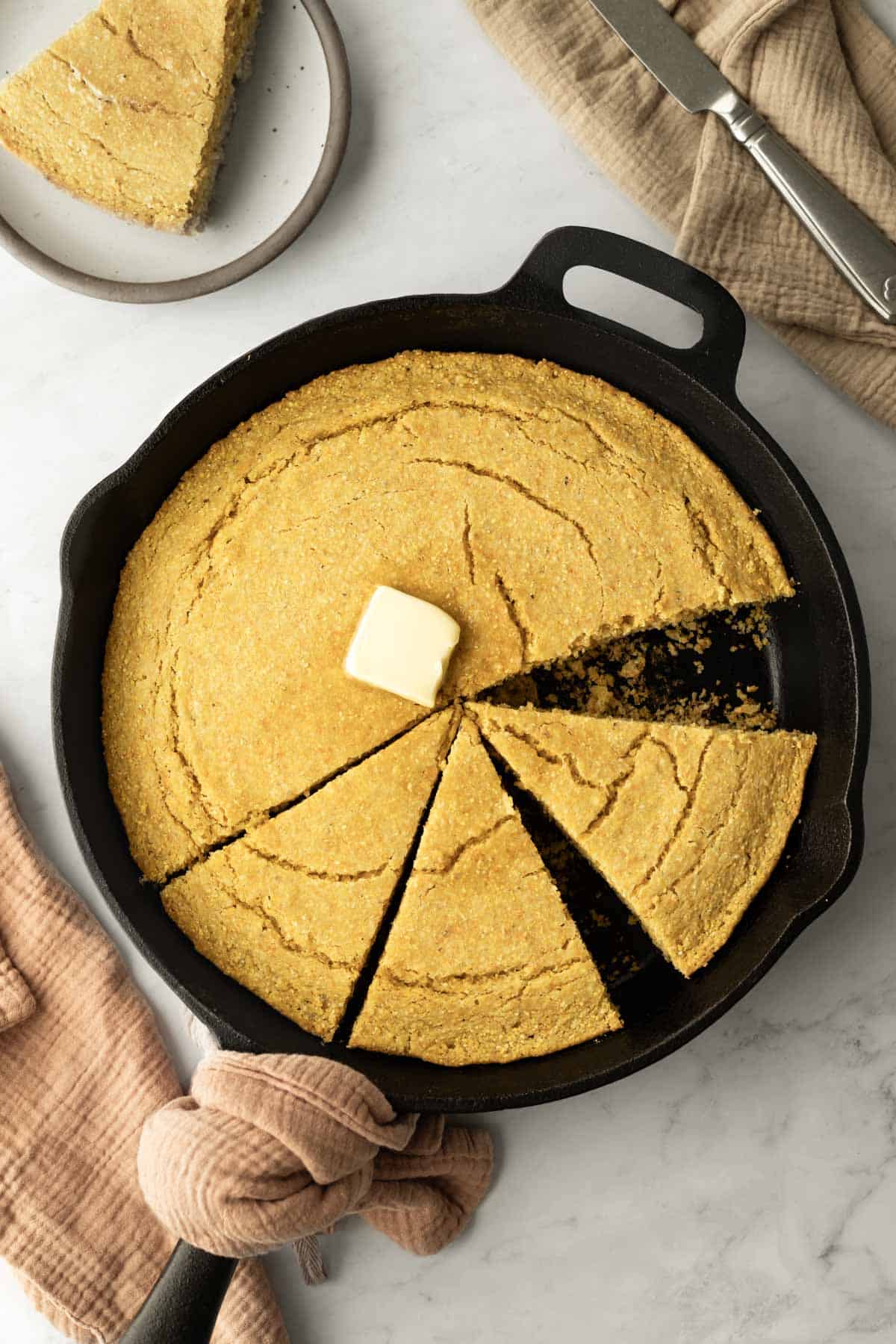
There's an old saying that goes something like, "There are two kinds of people in the world: those who like savory Southern cornbread and those who like cake. I mean Northern cornbread."
All joking aside, cornbread is quite the divisive subject. If you grew up eating a certain style of cornbread, you might not even realize there are other ways to make it and how passionately people feel about their cornbread.
And I totally get it because I, myself, am one who prefers the cornbread I grew up eating - Southern cornbread.
Unfortunately for vegans, good ol' Southern cornbread usually contains bacon grease (maybe even lard), eggs, buttermilk, and dairy-based butter.
So, I set out to make a version reminiscent of the one my mom used to make but 100% vegan!
If you're looking for more southern recipes made vegan, be sure to check out my Vegan Corn Pudding, Vegan Pimento Cheese, and Vegan Walnut Pie!
What's the difference between southern cornbread and other regional varieties?
Southern cornbread and northern cornbread differ primarily in their ingredients and preparation methods, reflecting regional culinary preferences and traditions.
Savory, rather than sweet, southern cornbread is made with significantly more cornmeal than flour and is often flavored with bacon drippings. On the other hand, cornbread enjoyed in the midwest or northern states is often on the sweeter side and more cake-like since it incorporates quite a bit more all-purpose flour.
Now here's where it gets even trickier... you may occasionally come across a southerner who says our cornbread is sweet. I grew up in Alabama and don't know anyone who'd agree! But the South is a big place.
Anyway, my point is that attempting to make definitive statements about who eats what and exactly where, is impossible. Cornbread is just like that!
So to continue with my generalizations, southern cornbread is typically baked in a cast-iron skillet, resulting in a crispy crust on the outside while remaining *only slightly moist* and somewhat crumbly on the inside. Northern cornbread is often baked in a square or rectangular baking dish, and is often lighter and fluffier in texture.
Southern cornbread is deeply rooted in Southern cuisine and is commonly served as a staple side dish with barbecue and alongside greens, beans, and chili.
Why You'll Love Savory Vegan Cornbread
- Classic southern cornbread flavor & texture without the animal products!
- Gluten-free as written which makes it great for all types of eaters.
- Easy 10 minutes of prep and 20 minutes bake time!
Recipe Feedback :
"This is it: the perfect southern-style (savory not sweet) cornbread! ...I’m hooked!" - Rena B.
Jump to:
- What's the difference between southern cornbread and other regional varieties?
- Why You'll Love Savory Vegan Cornbread
- Ingredient Notes & Substitutions
- How to Make Southern Vegan Cornbread
- Serving Suggestions
- Equipment
- Can I use a different size skillet?
- FAQs
- Helpful Tips
- More Cornbread Recipes
- Recipe
- 💬 Comments
Ingredient Notes & Substitutions
Here's a look at the main ingredients you'll need to make vegan cornbread. See the recipe card below for the full ingredient list and measurements.
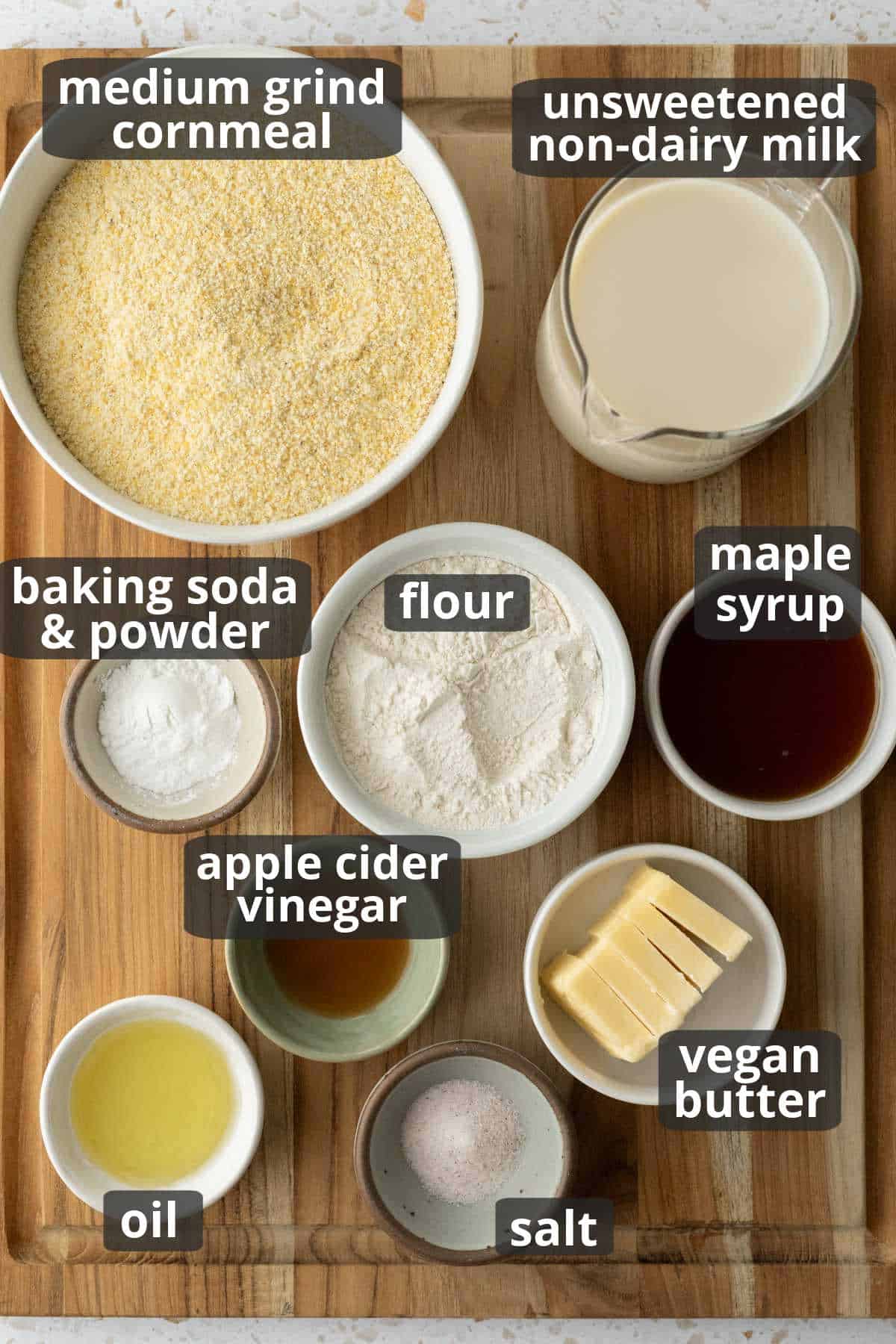
- Cornmeal - It's important to use good quality, stone-ground yellow cornmeal (sometimes called medium grind cornmeal). It typically has variations in texture, with some smaller pieces and some larger grit (it's not completely uniform like bread flour). This is important for achieving the proper texture.
- Flour - You don't need much since the cornmeal is the real star in this recipe, however, a bit does help with binding since this recipe doesn't use any eggs. I prefer this cornbread made with a gluten-free all-purpose flour blend, but you can use regular all-purpose flour or whole-wheat if you don't need gluten-free.
- Soy Milk - With higher protein and fat than some other non-dairy milks, I find that soy milk works well for most baking recipes. However, since the milk is used primarily to provide moisture, I suspect other plant-based milks such as oat milk or almond milk are fine. Just make sure the milk you're using is unflavored and unsweetened.
- Apple Cider Vinegar - This works with the soy milk to create a vegan buttermilk. It also reacts with baking soda to help with leavening.
- Vegan Butter & Grapeseed Oil - I find that the combination of these two fats works best in this recipe. The butter gives the cornbread a buttery flavor similar to the traditional non-vegan version, and oil adds just a bit more moisture. Feel free to swap the grapeseed oil for another neutral-tasting oil.
- Maple Syrup - I know some folks say southern cornbread should have no sugar, but for the sake of balancing the natural bitterness of cornmeal and enhancing the corn flavor, just a touch of maple syrup really rounds things out. But don't worry, it's not enough to make the cornbread taste sweet. Feel free to swap the maple syrup for agave nectar if you'd like.
How to Make Southern Vegan Cornbread
Start by placing a 12-inch cast iron skillet in the oven, then preheat the oven to 425°F.
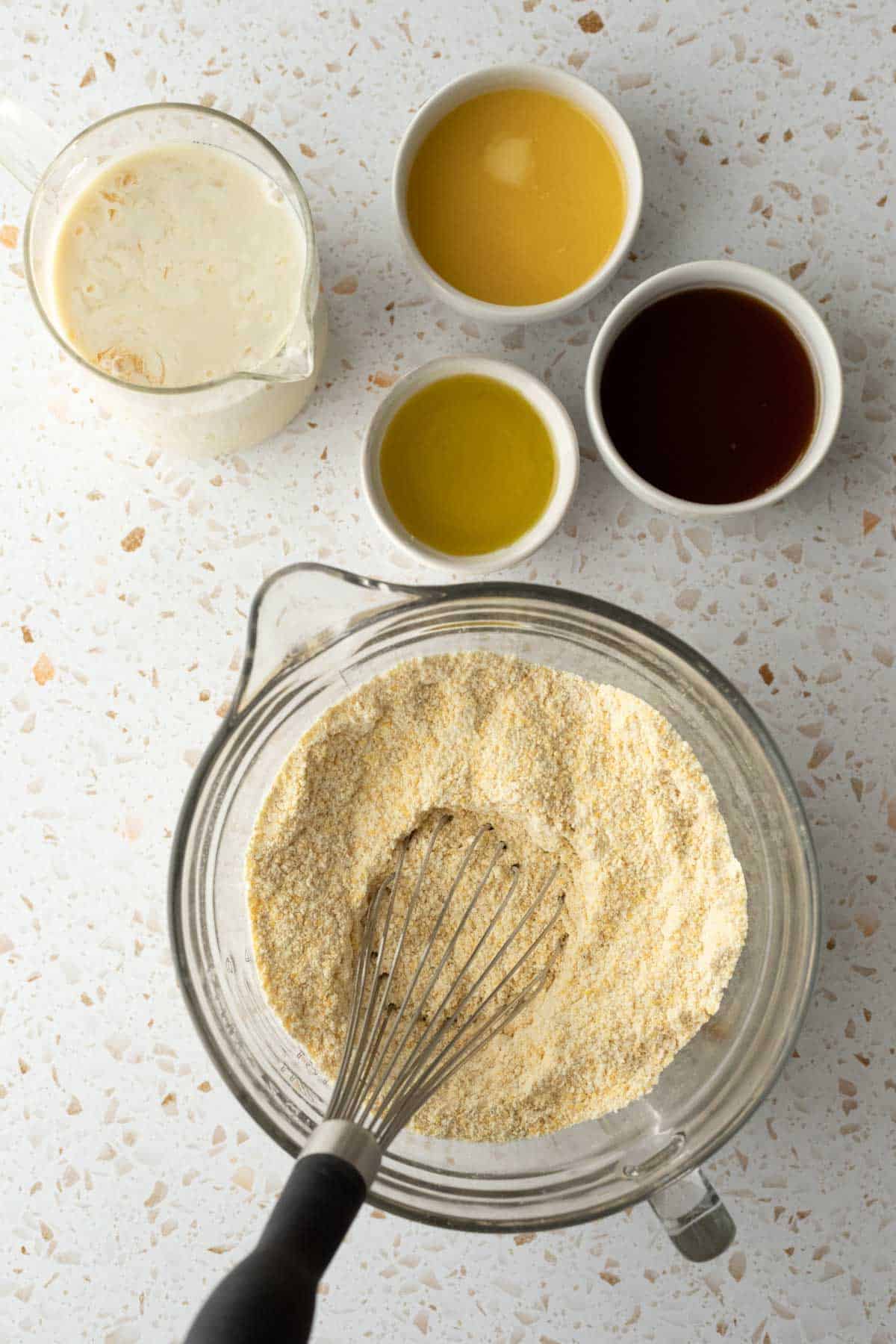
Whisk together the cornmeal, flour, baking powder, baking soda, and salt in a large mixing bowl. In a separate bowl combine the milk and vinegar to make "vegan buttermilk." Melt the butter in a mug or bowl.
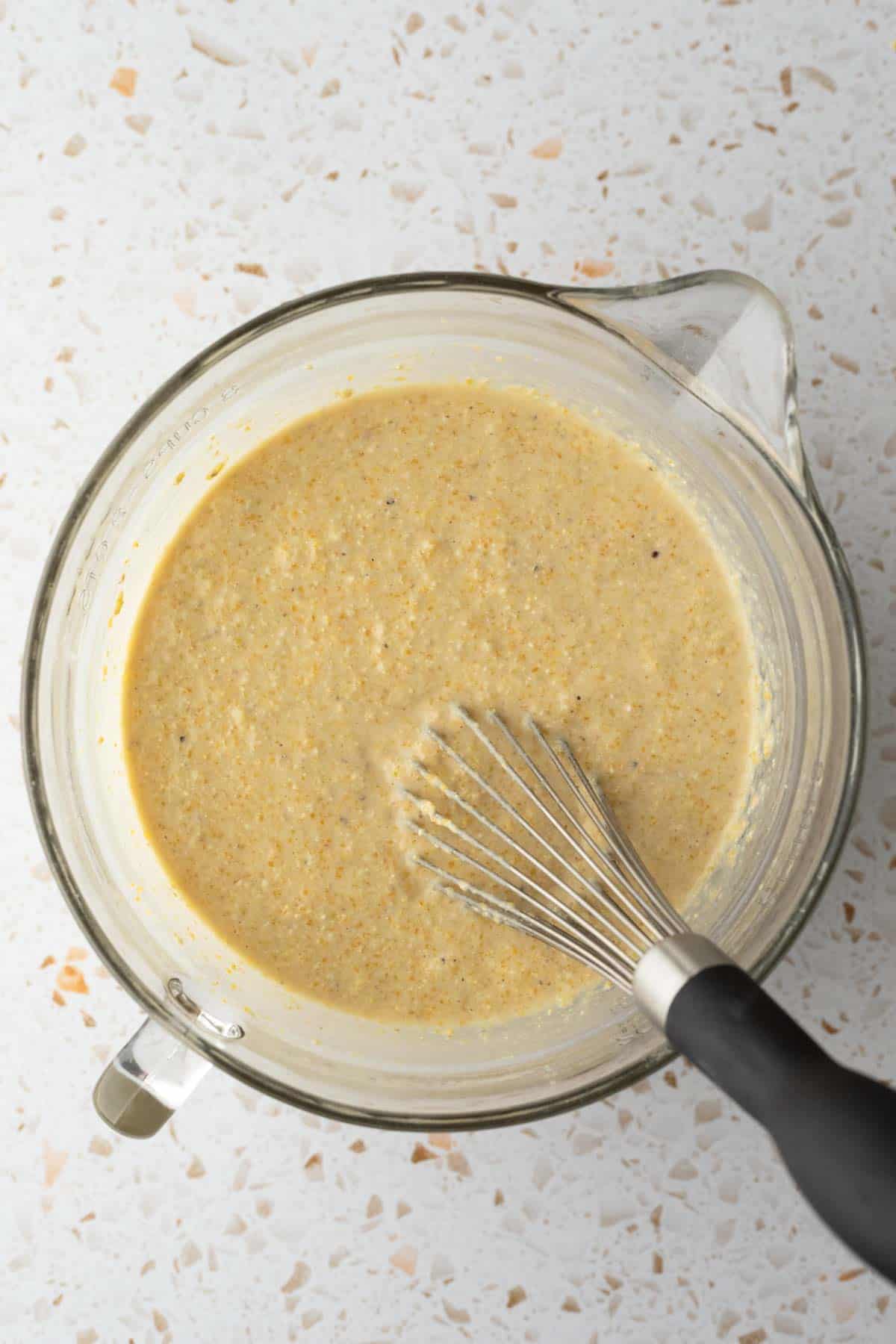
Whisk the maple syrup, oil, and melted butter into the vegan buttermilk. Pour into the dry ingredients, and whisk the batter until combined.
Want to save this recipe? 📩
Keep an eye out for more delicious recipes. Unsubscribe anytime.
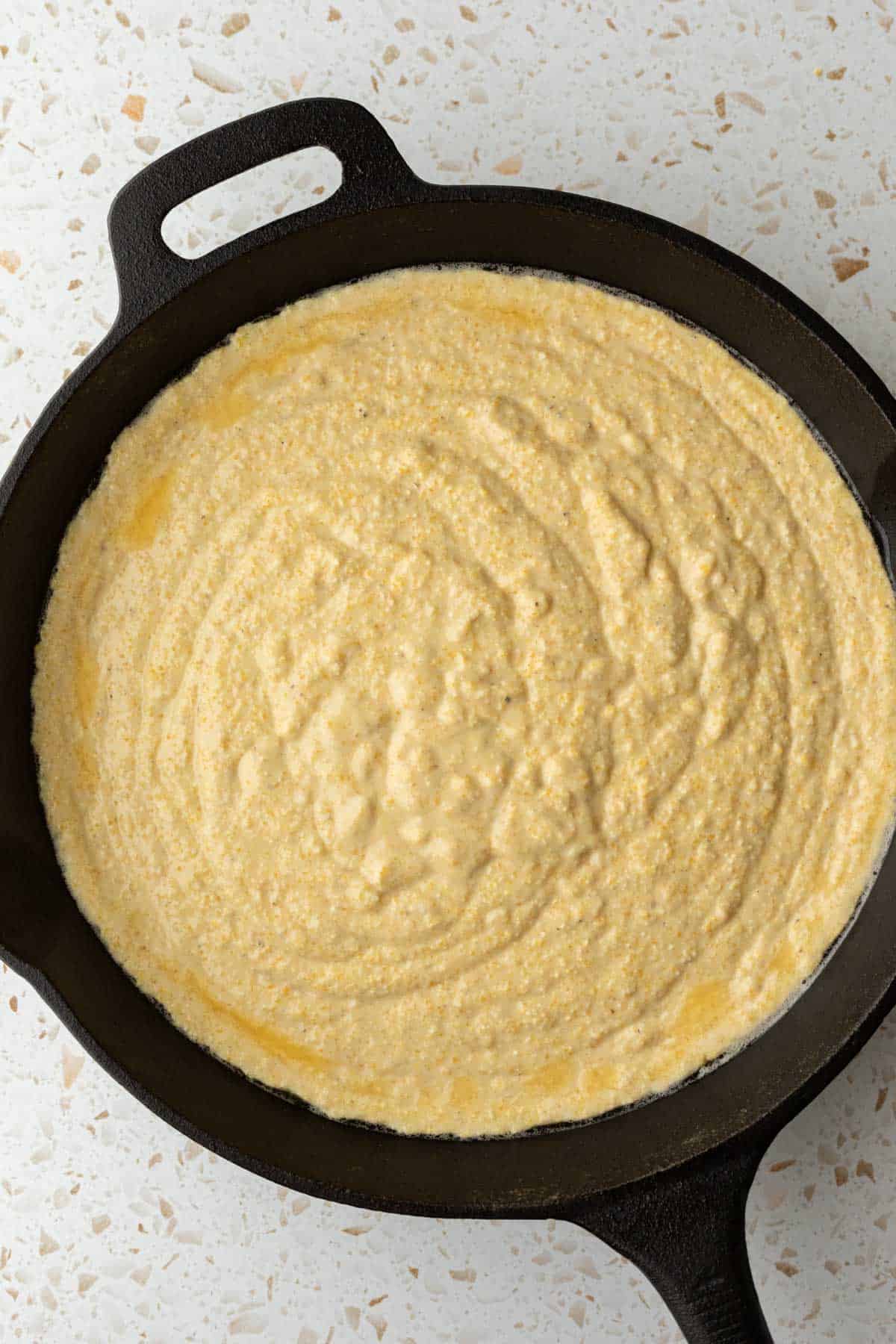
Remove the hot skillet from the oven, add a pat of vegan butter, and swirl it around so it coats the bottom. Pour the batter into the skillet, and bake for about 20 minutes or until a toothpick inserted in the center comes out clean or with a few crumbs.
Serving Suggestions
- Chili and cornbread are a match made in heaven! Try this vegan skillet cornbread with my Vegan Chili, Beyond Meat Chili, or Lentil Chili.
- Cornbread is also great served alongside a bowl of your favorite soup! Try it with Vegan Split Pea Soup, Lentil Cabbage Soup, or Creamy Vegetable Noodle Soup.
- This savory cornbread also pairs perfectly with stews like Charro Beans or Hearty Potato Stew.
Equipment
You'll need just one bowl, a whisk for mixing, a mug for melting the vegan butter, and a 12-inch cast iron skillet for baking the cornbread.
Can I use a different size skillet?
In testing this recipe I found that cooking it in a pre-heated 12-inch cast iron skillet is my favorite method. However, I realize you may want to use a standard 8x8 baking pan or a different size skillet.
In order to scale the recipe, we need to compare the surface area of the pans, adjust the ingredient amounts by the percentage of difference, and then keep an eye on the doneness of the center of the cornbread during cooking in case there's a bit of variance.
To calculate surface area of a round pan:
- 3.14 (aka π) x half the diameter of your round pan/skillet (aka radius) x half the diameter of your round pan again = surface area in square inches
For example, I calculated the area of my 12-inch skillet to be 113.
- 3.14 x 6 x 6 = 113 inches
Let's say you want to use a 10-inch skillet:
- 3.14 x 5 x 5 = 78.5 inches
Now, divide the area of the larger pan (113) by the area of the smaller one (78.5), and you get 1.44. Now, divide the amount of each ingredient by 1.44 to know how much you need.
Example: 3 cups corn meal divided by 1.44 = 2.08 cups
That's close enough to 2. So for a 10-inch skillet you would use 2 cups of cornmeal instead of 3.
Want to use a square pan?
Example: 8-inch x 8-inch = 64 square inches
Now, just like we did above, divide 113 inches (area as recipe is written) by 64 and you get 1.76. Divide the amount of each ingredient by 1.76, and you're ready to go!
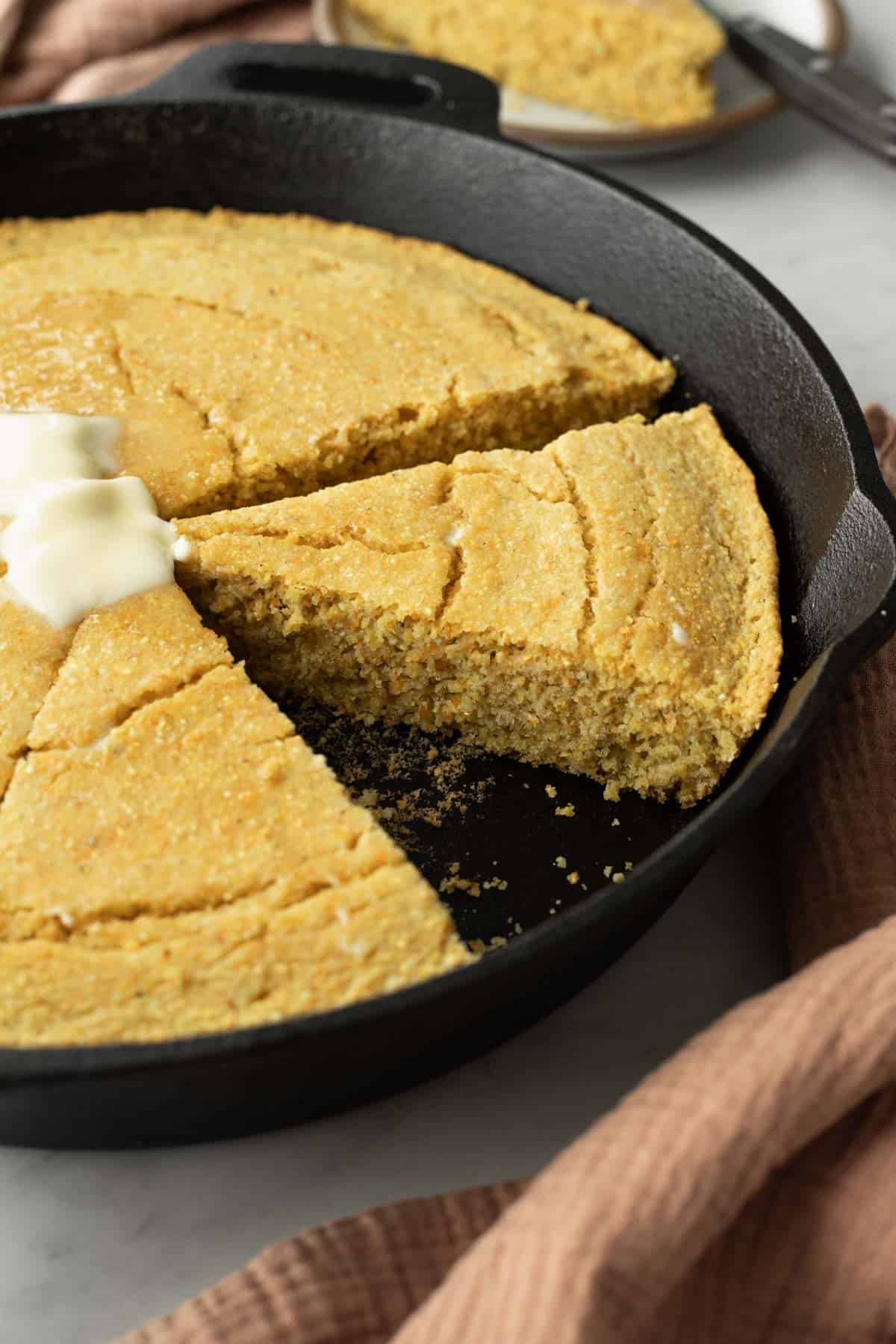
FAQs
The fats in this particular cornbread recipe are necessary for replicating the rich southern-style cornbread I grew up with. Instead, I recommend you try this Vegan Oil-Free Cornbread, which I developed to have a similar savory flavor - no fat needed!
Store the cornbread in an airtight container in the refrigerator for up to 4 days. You can also freeze it for up to a month.
Helpful Tips
- When combining the wet and dry ingredients, you want to whisk just until there's no visible dry flour. Note that the batter will look a bit lumpy.
- Remember that the cast iron skillet will be hot! So be sure to wear an oven mitt when moving it in and out of the preheated oven. It's also fairly heavy, so have a 2nd oven mitt on hand just in case.
- Let the cornbread to cool in the skillet for 20 minutes before slicing.
I hope you enjoy my southern vegan cornbread! If you try the recipe I'd love to hear from you. Comment below, and let us know how you served it up!
More Cornbread Recipes
Recipe
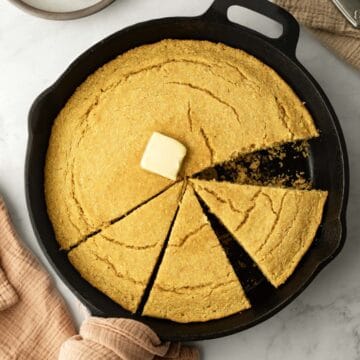
Vegan Cornbread (Savory, Southern-Style)
Ingredients
- 2¾ cups stone-ground yellow cornmeal - sometimes called medium-grind
- ¾ cup gluten-free or regular all-purpose flour - see Notes
- 2 teaspoons baking powder
- 1 teaspoon baking soda
- 1¾ teaspoons fine sea salt - use 2 teaspoon if you like it salty
- 2 cups unsweetened, unflavored soy milk
- 2 tablespoons apple cider vinegar
- 5 tablespoons vegan butter, divided
- 3 tablespoons maple syrup - or agave
- 3 tablespoons grapeseed oil - or other neutral oil
Instructions
- Place a 12-inch cast iron pan in the oven and preheat to 425 degrees.
- In a large bowl whisk together the cornmeal, flour, baking powder, baking soda, and salt.
- Make "vegan buttermilk" by combining the milk and vinegar in a medium-size bowl. Set aside. Place 4 tablespoons of the butter in a mug or small bowl. Microwave for about 15 seconds or until just melted.
- Add the melted butter, maple syrup, and oil to the buttermilk, and whisk to combine. Pour wet ingredients into the dry ingredients, and whisk or stir just until there is no visible dry flour. The batter will look a bit lumpy.
- Carefully remove the hot skillet from the oven and add the extra tablespoon of butter. Again, carefully (remember to put on your oven mitt before grabbing the handle) tilt the pan to swirl the butter around so it coats the bottom. Immediately pour the batter into the pan. Bake for 19 to 23 minutes. Use a toothpick or knife inserted in the center to test for crumbs/doneness.
- Let the cornbread to cool in the pan for 20 minutes before slicing.
Notes
Estimated Nutrition (per serving)
Nutrition information is an estimate and will vary depending on the exact amounts and specific products and ingredients used.
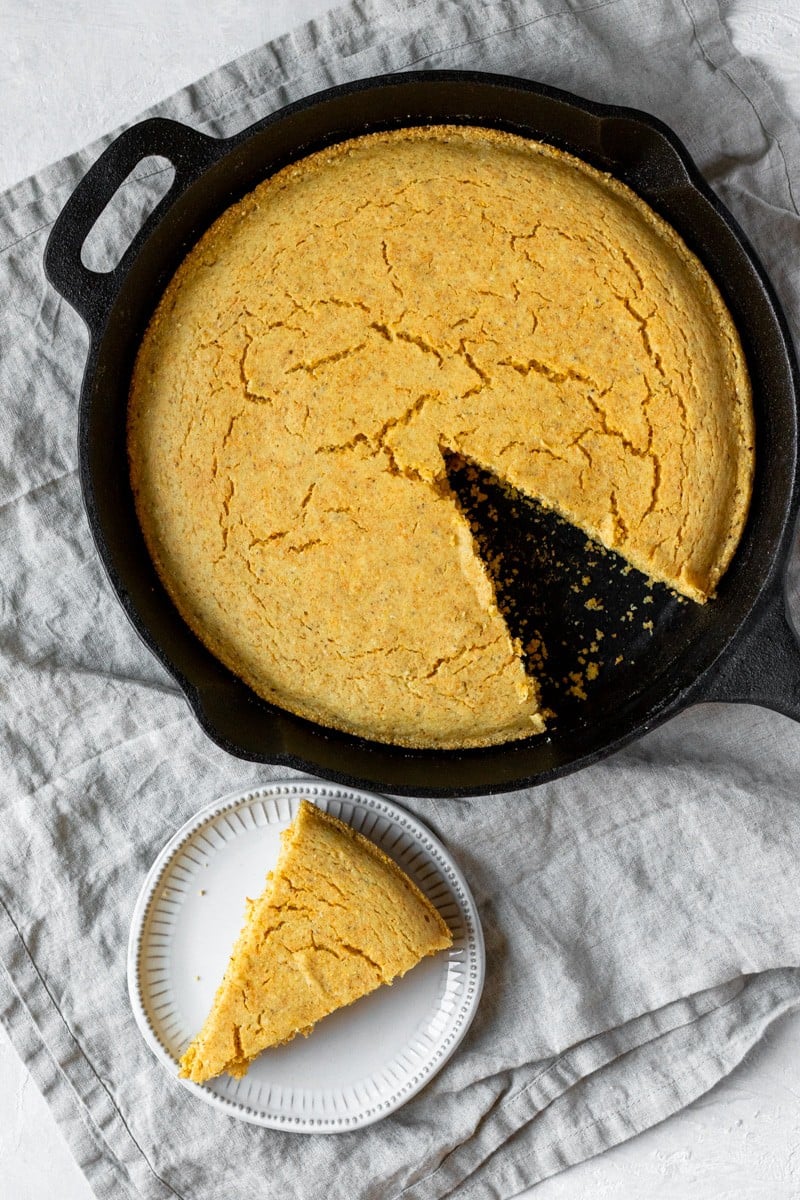

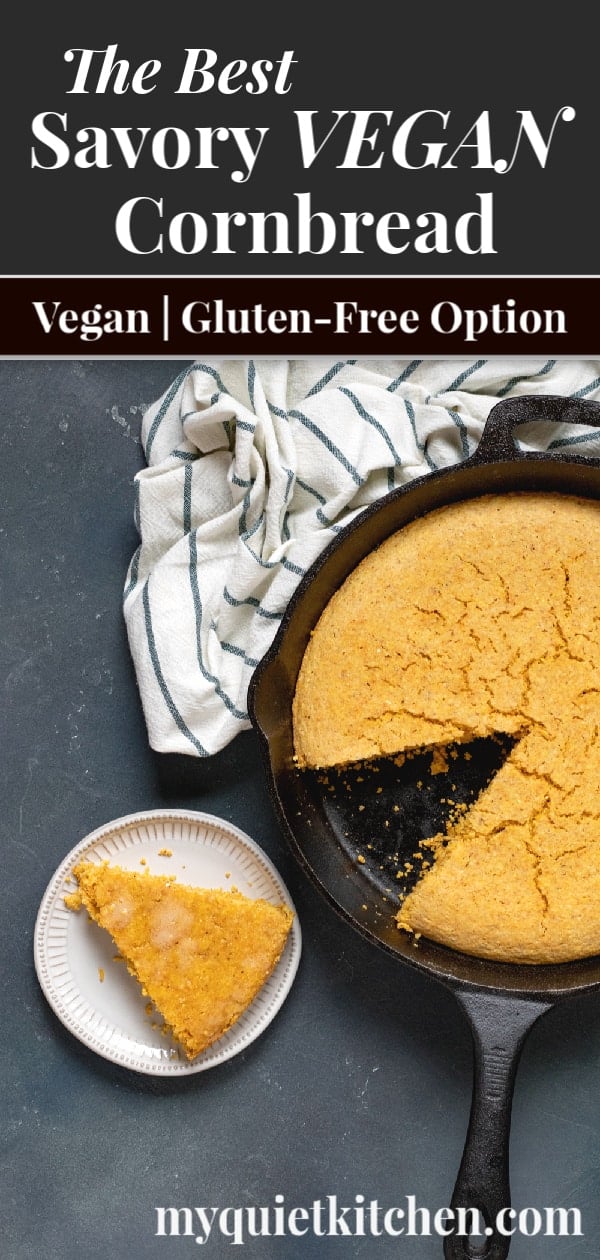
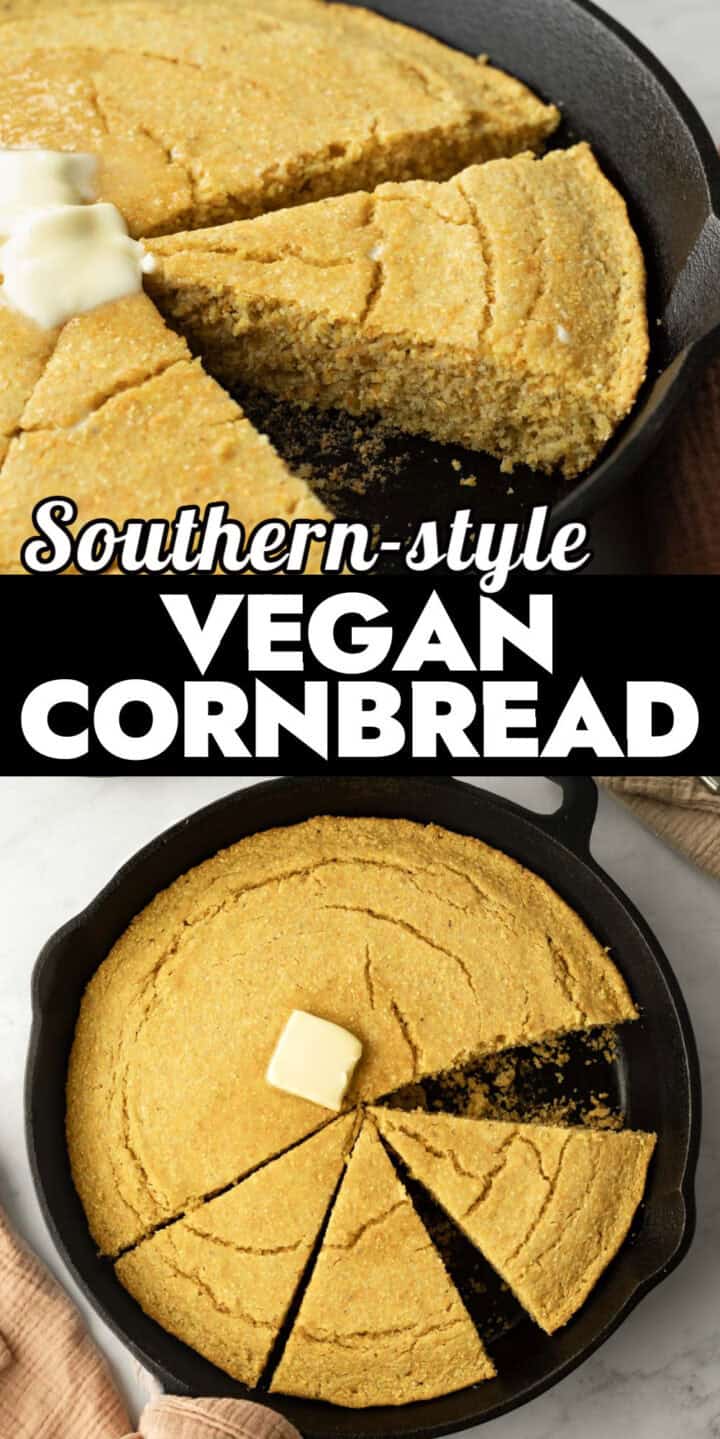
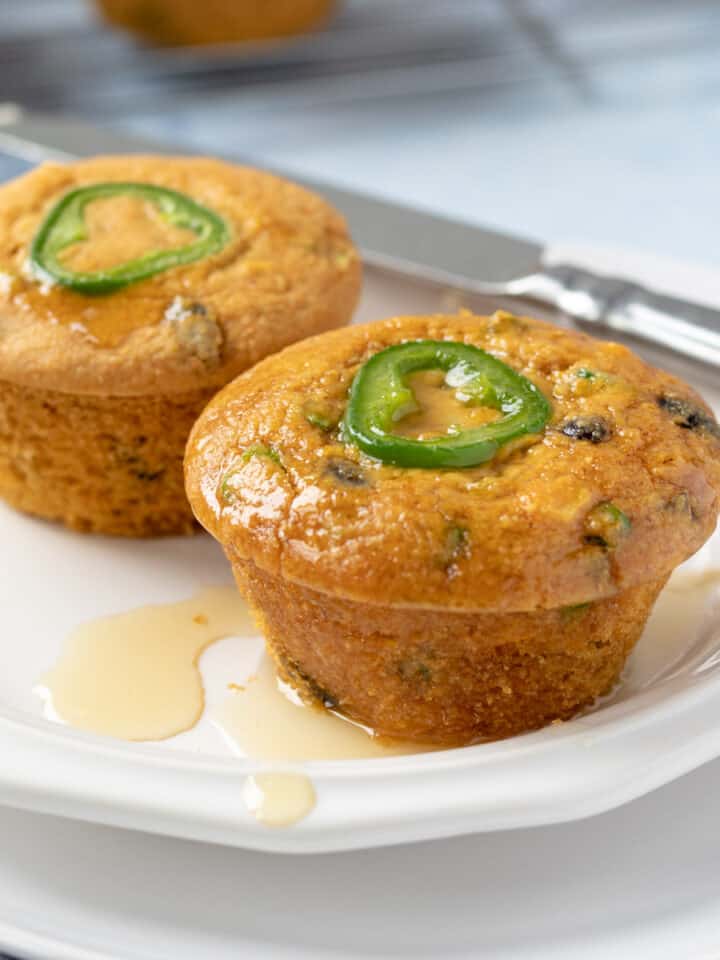
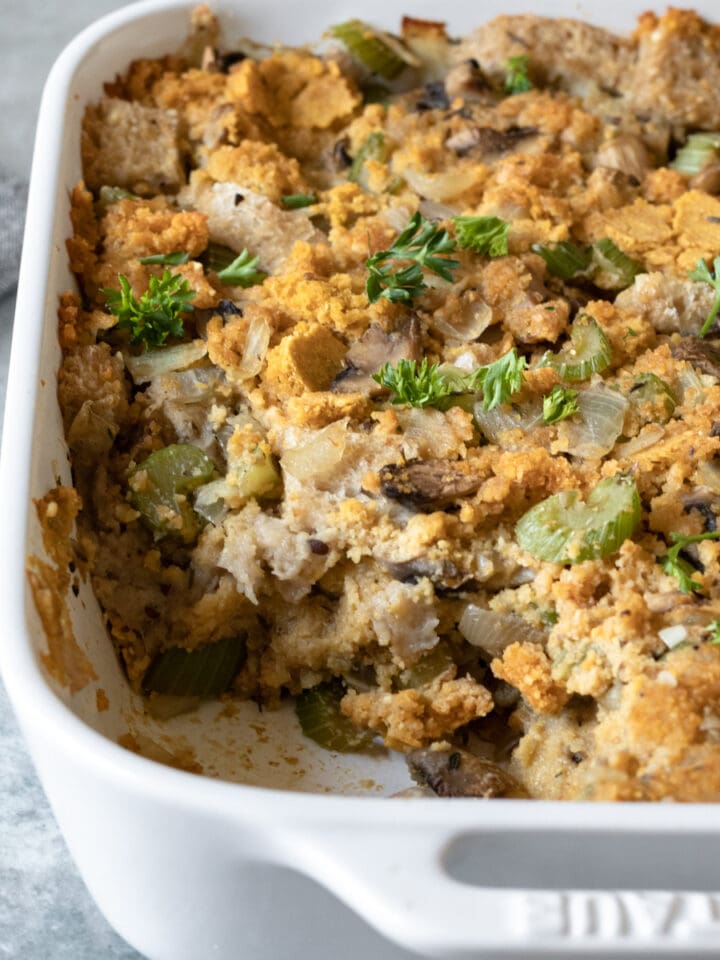
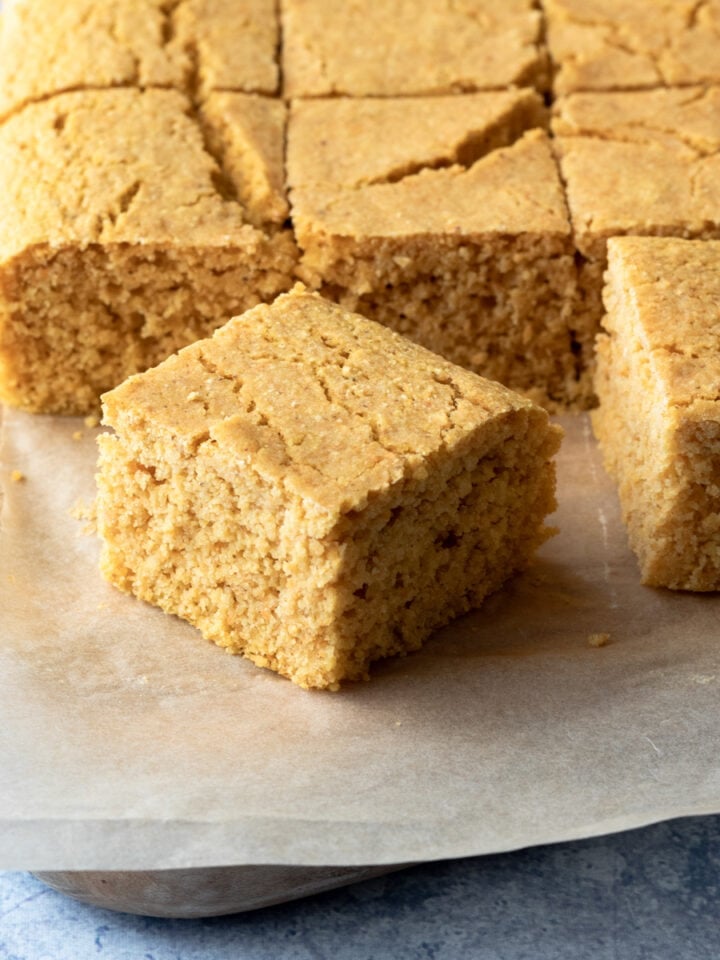
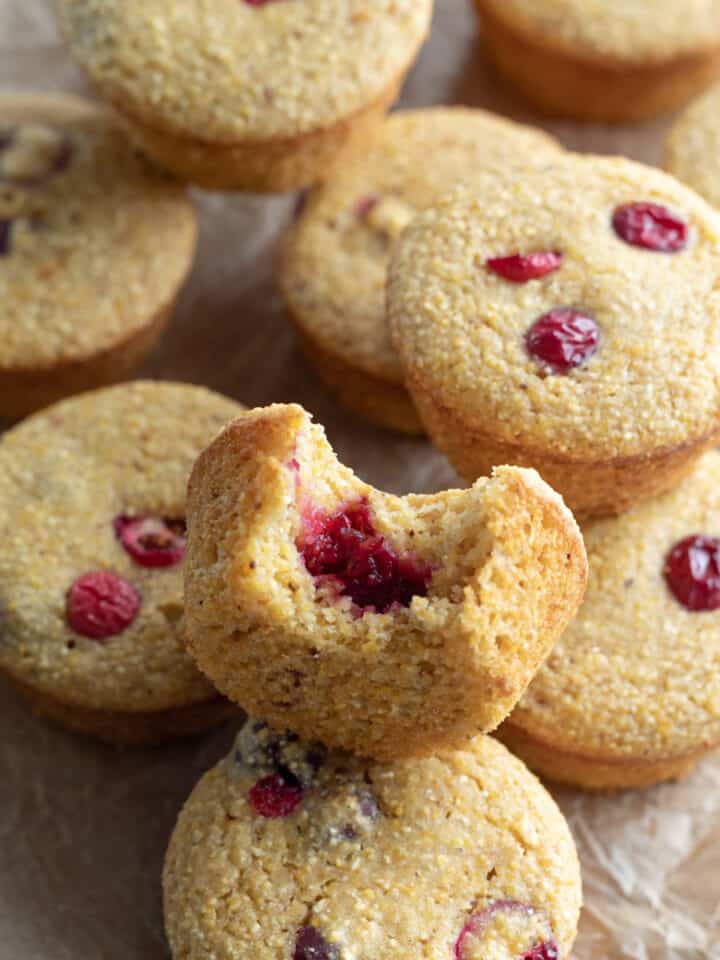
Taylor says
I made this last night and it was great! I didn't think I'd like crumbly cornbread, as I'm not a southerner and I like my cornbread moist and sweet usually, so I made it with the noted variation. It was so good! I think I've been confusing dry, poorly made cornbread, with crumbly cornbread. Next time I'll make the more crumbly version to compare. Thanks for a great recipe.
Becca says
Can I leave out the flour and syrup? I learned to make cornbread from my grandmother and great-grandmother. They were both of the mind that cornbread shouldn't use anything but cornmeal of whatever variety of grind you could find and there shouldn't even be a hint of sweetness. They both took their recipes to the grave because my mother and her sisters were not interested in cooking. Now I am stuck looking for the recipe that tastes the closest to theirs that I can either make vegan or is vegan
Lori says
Hi Becca,
Their recipe sounds delicious, and you can probably tell I lean heavily toward agreeing with them! 🙂 You can certainly experiment with the amounts, but I have two main concerns with omitting the maple syrup and flour in this vegan version:
Since we're not using eggs, the flour acts as a binder. This recipe used to call for only 1/4 cup flour and 3 cups cornmeal. We enjoyed that version of the recipe but some people complained that it was too crumbly. You might prefer that version (also increase the vegan butter by a couple of tablespoons). Another fun experiment would be to add JustEgg.
The 3 tablespoons of maple syrup don't make the cornbread sweet at all. It softens any bitterness from the cornmeal and rounds out the flavors. But you can definitely experiment with less of that ingredient. If you give it a try let us know what changes you make and how it turns out!
Rena Buchanan says
This is it: the perfect southern-style (savory not sweet) cornbread! I followed your recipe, used regular flour instead of gluten-free, pecan-cashew milk and a different vegan butter because that’s what I had on hand. It baked perfectly following your cast-iron skillet instructions, including the cool-down time before slicing. I’m hooked!
Lori says
That's great to hear, Rena! I'm so glad you love it.
Larissa McGovern says
I tried this, I did not have any syrup so I just used the same amount of organic sugar. I noticed it was very salty (I witheld 1/4 tsp too), and very crumbly. I also did use coarse cornmeal because that's what I had, so that might've made it more crumbly. I usually like to make a recipe for the first time to a T so that I can tweak it afterwards if I need to, but with this I did deviate a little.
Sharan says
I made this the other day because I have not found a savory cornbread since switching from vegetarian to vegan which is a long time. I was born and bred in the south and still live in the south but my family did not do sweet cornbread. I have tried and failed to find one that works. This one was the closest and it was delicious. I did not use any sweetener although the recipe called for it.
My only complaint is it is very crumbly. Not sure why yet.
The flavor was great and so perfect with the pot of southern pinto beans I cooked. Thank you so much!
Lori says
Hi Sharan, so glad you liked it! The crumbliness is due to the lack of gluten. Most cornbreads call for a very different ratio of flour to cornmeal than this one, but I wanted corn flavor to dominate so I kept other flours to a minimum. You could adjust the ratio a bit, and that would help it hold together.
Margaret says
So, there are a few things I will "cheat" on and that's what it takes to make a good cornbread. So yeah, I will eat eggs, buttermilk, and butter in order to enjoy a good skillet cornbread. Its pretty much the only baking I do. But if I can find a satisfactory vegan cornbread recipe, I will switch. I just haven't found one yet. The other day I made a brown butter skillet cornbread that was even better than the recipe I had been using. Do you think vegan butter will brown in the same way as regular butter? I'm thinking not, but wondering if you've tried it? - Margaret
Lori says
Well, I may just have to make it my new mission to come up with a vegan brown butter cornbread! 😀 I've actually never had brown butter cornbread before, but it sounds delicious. Since the browning of dairy butter depends on the proteins, and the chemical makeup of vegan butter is different, the method may take some tweaking. But I know it is possible. Adding that to my to-do list. Stay tuned!
Margaret says
I'm excited!
Taylor says
I know this comment is older at this point, but Miyoko's butter is supposed to brown. I'm not sure if it has the same flavor profile or not, but it's something to think about!
Gil Vega says
If I were to substitute apple sauce for the vegan butter, should I do so in the same amount? What are your thoughts on that substitution?
Thanks.
Lori says
Hi Gil,
You may prefer this Oil-Free Cornbread.